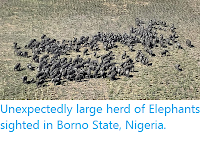As desert specialist rodent species, African Jerboas, Jaculus spp., have drawn the attention of researchers due to their broad distribution across the Saharan-Arabian region and their high phenotypic and genetic variation. Within the five recognized species in the genus, particular attention has been given to two putative sister cryptic species, the African Hammada Jerboa, Jaculus hirtipes, and the Lesser Egyptian Jerboa, Jaculus jaculus, sometimes considered as a single species due to incongruences between molecular and morphological studies. Cryptic species are species that closely resemble other species, and
cannot be separated by simple, non-invasive examination. While taxonomists have
known about cryptic species for a long time, it was not realised how numerous
such species were until taxonomists began to use genetics to determine relationships
between species, about twenty years ago. The presence of cryptic species can
have a profound influence on conservation efforts, as ‘species’ thought to be
wide ranging with large populations and broad environmental tolerances can turn
out to be complexes of closely related but reproductively isolated species,
each with a smaller population and distribution, and narrower range of
environmental tolerances.
In a paper published in the journal BMC Evolutionary Biology on 13 February 2020, Ana Filipa Moutinho of the Department of Evolutionary Genetics at the Max Planck Institute for Evolutionary Biology, and the Research Centre in Biodiversity and Genetic Resources and the Department of Biology at the University of Porto, Nina Serén, also of the Research Centre in Biodiversity and Genetic Resources and the Department of Biology at the University of Porto, and of the Division of Ecology and Evolutionary Biology at the University of Jyväskylä, Joana Paupério, again of the Research Centre in Biodiversity and Genetic Resources at the University of Porto, Teresa Luísa Silva, again of the Research Centre in Biodiversity and Genetic Resources at the University of Porto, and of the Life and Health Sciences Research Institute at the University of Minho, Fernando Martínez-Freiría, Graciela Sotelo, and Rui Faria, again of the Research Centre in Biodiversity and Genetic Resources at the University of Porto, Tapio Mappes, also of the Division of Ecology and Evolutionary Biology at the University of Jyväskylä, Paulo Célio Alves and José Carlos Brito, again of the Research Centre in Biodiversity and Genetic Resources and the Department of Biology at the University of Porto, and Zbyszek Boratyński, once again of the Research Centre in Biodiversity and Genetic Resources at the University of Porto, present the results of a genetic study based upon mitochondrial DNA designed to resolve the status of the two species.
Northern Africa holds a great biogeographical interest owing to the strong species interactions (such as the competition for limited and ephemeral resources), the wide diversity of habitats and heterogeneous landscapes, and the complex palaeoclimatic and geological history. Available phylogeographic studies in this region have uncovered substantial taxa diversification induced by the climate shifts that occurred during the Pliocene-Pleistocene interval (from about million years ago onwards) and the successive range shifts of the Sahara Desert. These climatic fluctuations caused significant movements of the Sahara-Sahel boundaries, leading to alterations in the ecological composition of landscapes. Such dynamics resulted in new selective pressures and/or geographic isolation within lineages, causing events of genetic diversification, adaptation, and eventually speciation.
Moutinho et al. sampled mitochondrial DNA from both putative species from eleven countries across the Saharan, Sahelian and Arabian regions; Mauritania, Morocco, Mali, Niger, Tunisia, Libya, Algeria, Senegal, Egypt, Kuwait, and Israel. Because mitochondrial DNA is
found in the mitochondria, organelles outside the cell nucleus, it is
passed directly from mother to child without being sexually
recombined each generation, enabling precise estimations of when
individuals shared common ancestors, at least through the female line
(it is also possible to trace direct ancestry through the male line,
using DNA from the Y chromosome, which is passed directly from father
to son without sexual recombination).
A Lesser Egyptian Jerboa, Jaculus jaculus, (top) and an African Hammada Jerboa, Jaculus hirtipes, (bottom). Moutinho et al. (2020).
Moutinho et al. found that all of the Jerboa's sampled belonged to two haplogroups (a haplogroup is a
group of individuals shown to share a common ancestry through the male
or female line, using either mitochondrial or Y chromosome DNA), which corresponded to the two species, strongly supporting the idea that these are true biological species (i.e. species which do not interbreed).
Phylogenetic relationship of Jaculus individuals and their geographic distribution across North Africa. a Phylogenetic tree based on Bayesian inference showing the relationship among the haplotypes of two Jaculus species for the cytb gene. Values on branches indicate Bayesian posterior probabilities support and bootstrap values of Maximum-Likelihood analysis, respectively. White circles indicate posterior probabilities and bootstrap values above 0.91/91, respectively, for internal nodes. On each clade, the respective species is indicated. Jaculus orientalis (seven individuals, belonong to two haplotypes) was used as outgroup. Each tip of the tree branches is coloured according to the country of origin of each individual belonging to a haplotype. (b) Geographical locations of all Jaculus individuals used in this study. Red (circles) and green (triangles) samples denote, respectively, Jaculus jaculus and Jaculus hirtipes. Moutinho et al. (2020).
Both species were highly variable across their range, suggesting degree of environmental flexibility, with populations adapting to local environmental conditions. Interestingly, for both species individuals from Israel, where it has previously been claimed that the two species are more easily differentiated than in other areas, form distinct clusters, which may indicate some level of geographic isolation from other populations, and potentially niche partitioning between the two species (i.e. the two species may avoid competing with one another by occupying different ecological niches).
See also...
Follow Sciency Thoughts on Facebook.









